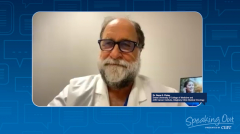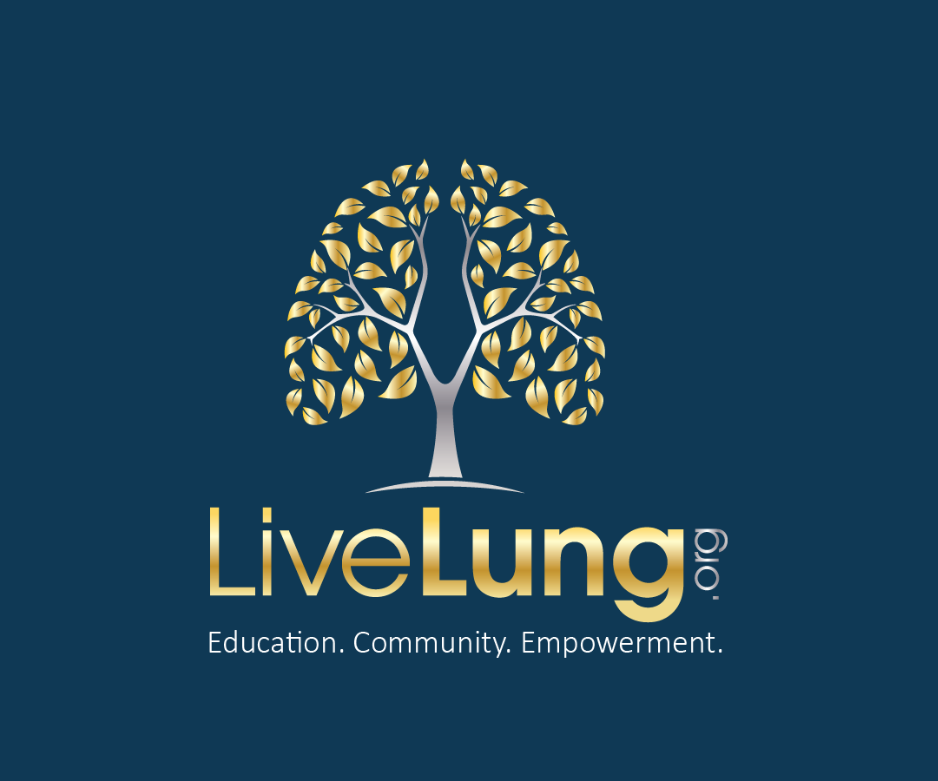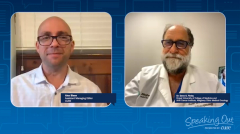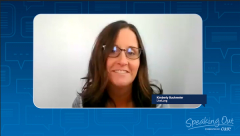
‘It Can Happen to Anybody’: Lung Cancer Survivor Shares Radon Exposure Story

As part of its Speaking Out® video series, CURE® spoke with Kimberly Buchmeier, a lung cancer survivor and board member of LiveLung.
Episodes in this series
Alex Biese: Hi, my name is Alex Biese, I'm the assistant managing editor of CURE® magazine, and in this edition of the Speaking Out® video series we're speaking with Kimberly Buchmeier about radon exposure. Kimberly, thank you so much for taking some time to talk with me today.
Kimberly Buchmeier:You betcha. Thank you for asking me.
Biese: It's my pleasure. So to start off, tell me a bit about your life before the start of your cancer journey.
Buchmeier: Well, my life was busy. I was young. Before I was diagnosed, I was 36 years old and I had a busy life, I was owning my own business, several businesses actually, I was an entrepreneur with a busy family, three kids in my home. I had a husband that was working all the time as well. We just were really living our best life. I mean, things were just rocking and rolling. And we were doing life and doing it well, actually, I felt like, anyway. And then that came to an abrupt halt.
Biese: And how did that halt come about?
Buchmeier: So, I was diagnosed with lung cancer in January of 2011. And at that point, I had had a birthday. So I was 37 years old, young, healthy, vibrant, active, I exercised all the time. Just real busy. The year before that, though, let's back up, in 2010, I had been just not feeling great. And I just couldn't put my finger on it. And neither could the doctors. So I had been seeing quite a few different doctors. And nobody really knew what was going on. And I couldn't honestly tell them sometimes what was happening, I just didn't feel right.
Something wasn't right. I had this severe back pain, but we just couldn't find it. If you pushed on my back, I didn't have any physical pain you could touch and I just wasn't filling myself. A lot of fatigue. And I kept getting these colds. So I'd have like an upper respiratory cold. And I kind of felt like I had it all year long in 2010. So I had seen a couple of doctors and nobody just had an answer. And I kind of let it go in the fall of 2010. And it was busy, and it was the holidays.
And then when January hit, 2011, I was really feeling bad. And I thought, "I gotta give this one more try. So I'm going to find a spine specialist," because that's where my pain was, it was in my back. So I met with a spine specialist on a Thursday morning. And he said, "Oh, you know, let's just get a picture of your back. Let's do a scan and I'll get the results back. But I won't probably have him back till Monday morning. That's okay, I'll call you with the results."
And sure enough, at 8:04 on that Monday morning, he called me and he said, "Um, we got a problem. And I need to know where you're at because I need you to get to the hospital right away. We need to run some more tests, we found a mass on your lung." And I was like, "What?" And I just didn't comprehend what he was saying. He's like, "Can you get to your hospital? I've called your hospital," and this doctor was an hour away from my town. I live in a very small town. He was in the city. And he said, "I've already called there and I have a doctor waiting for you." I was like, "Geez."
So we went to the doctor. They did some more scans. And I remember sitting there in the doctor's office and the doctor looked at me and he patted me on the hand and he had tears in his eyes and I thought, "Oh crap, I'm in trouble." And he was teared up. I was consoling him. He's like, "I really think you might have lung cancer, but we're going to have to do a biopsy, I'm going to send you to an oncologist," and I'm just like, "Oh, okay," I'm not freaking out. And I'm by myself. I told my husband to stay home because it's going to be no big deal, not a big deal. And so this doctor, he's teared up and he was kind of young too. And he's just like, "You're 37. This isn't supposed to be happening to you." And I was like, "Oh, it'll be fine. Not not not a big deal." And so I'm consoling him.
And then after that it just took off. I had to have a lung biopsy and then I had to have a lower lobectomy in the lower lung in March. And then after that I had to do chemo. So I did chemo till August. And in fact, I was supposed to do chemo for an entire year. But the chemo was literally killing me, and so they felt like I was in a good spot to pull it off because it was really, really bad. The side effects were really bad. And I just wasn't going to survive it. So, luckily for me, we caught it early. Luckily for me, I got to have surgery, a lot of lung cancer patients don't get surgery. And then I had chemo. And here I am. And everything is going great. So I just had a checkup this summer and everything looked great.
Biese: Well, I'm very happy to hear that the story at least has that ending.
Buchmeier: It does. Yeah, I mean, we've had some scares along the way. I had scans every three months, six months, graduated to a year. My oncologist says there's no protocol for somebody like me, so I have to go back every year. Normally, they would have released a lung cancer survivor by now in my situation, but they just can't, he just doesn't feel comfortable letting me not come in for scans. So I do low-dose CT scans annually.
Biese: And when did the issue of radon enter the conversation?
Buchmeier: So it didn't enter the conversation right away. I had to get through surgery and chemo and kind of like the next year when I was going back to the doctor, I would read all my reports, I was really into like advocating for myself and really wanting to understand what was going on. Because I couldn't figure it out. I did not smoke. My family didn't smoke. Nobody did. So I just couldn't figure it out. And I started doing some research and just looking through the paperwork, and there's something in my paperwork that kept coming up, off and on that said "most likely due to environmental factors."
So I remember being in the oncologist's office and I remember asking him, "Hey, I saw something about my lung cancer that it might be due to environmental factors. What are you talking about?" He's like, "Well, you know, there are some things, like high levels of radon, but you don't have that your home, right?" And I was like, "Hmm, I don't know, I don't even know what that is," And I just thought, "Okay," so I let it go. Didn't deal with it, got through 2012 where I just had to recover, get my family back to normal, get my life back to normal, get my job back. I owned a business. I had to get that going.
And I remember thinking, "I still need answers." So I started Googling stuff. Like, "What is lung cancer?" "What is radon?" "What does lung cancer with environmental factors mean?" And every time I did that, radon was just like, boom, boom, boom, coming up on the screen. I started researching radon, radon in your home. And I thought, "Hey, well, you know what? We should just test our home." So I, even then, told my husband who was also busy, "Hey, let's test our home for radon." (He said,) "Yeah, yeah, yeah, I'll do that." We let a couple months go by. And I was like, "Hey, remember I told you I wanted to test her home for radon? Let's do it."
So we did it. And our radon reading came back super high. So if you're familiar with what your level should be, we were at 29.9. And your radon levels in your home should be under four. So on a massive scale, 29 doesn't sound big, right? Because we go by everything in the hundreds, like if you're 100%, whoa, like that's all in, but 29? With a radon level, 29, that's huge. That's like over 100%. So I knew I had a problem. And right away we just called somebody, a specialist, and we're like, "We need to get this radon out of our home because we have kids living here." And I really found out a lot more about radon. My living room, we had a living room in the basement of our house. We built our house, by the way, found out and built it on an old rock quarry, bad for radon, a lot of radon comes up through that kind of soil. And we had our living room downstairs, my bedroom was downstairs. So I was sleeping downstairs where most of your radon is coming in through your house.
It was actually really scary that I did this to myself because I wasn't educated when I built a house. Nobody told me when I built our house, "Hey, you should put in a radon mitigation system. You live in the country in rural America, you might have high levels of radon." I didn't have any of that education. And so from then on, I made it pretty much my life's passion to educate people on radon and lung cancer, because it is real. It happens. It happened to me. It can happen to you. It can happen to anybody. So, that's the radon part of that story.
Biese: So to that end, for anyone who's watching this or reading this, what should they keep in mind in terms of assessing their own risk for radon exposure?
Buchmeier: Well, it doesn't matter where you live. For me, I live in rural America, I live in rural Nebraska and it doesn't matter if I built my house. It doesn't matter if I live in the country or if I built on an old rock quarry. It doesn't matter. Any house in any neighborhood can have radon levels. So you absolutely need to make sure if you're building a house, buying a house, you live in your current house, test it for radon.
Because really, first of all, could you get lung cancer from it? Absolutely. But it just is good for your health to get that radon out of your house and find out if you have it, because your neighbor might not have any radon, like low levels, you might be over here. I've met people who have been in the 50s. But their neighbor who was like eight, because it doesn't matter. It just depends on what's going on right there where your house is. So I really think people just need to, they just got to test it. Don't wait for it to happen to you. Just test your house.
Biese: And are you and your family still living in the same home? And if so, what sort of remediation steps have you taken?
Buchmeier: So we are living in our home and I wanted to move, I wanted to burn it down. I was like "I don't want to live here anymore," because I was so scared for my children and our pets. You know, I was just really worried about our visitors, I thought, "Oh my gosh, no one's gonna want to come to my house." But that's not the case. So we just did a mitigation system, we had a professional come and test to make sure our numbers were high. They were and then we did a mitigation system, put a radon fan in, ran it through the house.
And since then, we've upgraded our radon fan once, just to make sure because we thought maybe it wasn't working at one point. And we've got a little level in the basement, we can kind of tell where it's at if maybe the radon fan wasn't working, because here in Nebraska ice can build up on it, you just got to really make sure that it's working good. And it is. So it's exciting to have that taken care of and people want to come visit me, they're not scared on my house.
Biese: So is there anything else on this topic that you would like our our viewers and readers to be aware of?
Buchmeier: I just want to reiterate the testing part about radon, because it's so easy to test, it's so cheap, you can go to a hardware store and get a test, you can buy them off Amazon, you they're like 10, 20 bucks, if you don't want to go that professional route. And then once you get those results back, because you get them back fairly quickly, then you can get a professional involved. But I just want people to know that it's not hard to do. It's super easy, and it's super affordable.
Biese: Got it. Well. Kimberly, thank you so much for your time today, for sharing your story and your perspective. We appreciate it. Hope you have a great day.
Transcription edited for clarity and conciseness.









